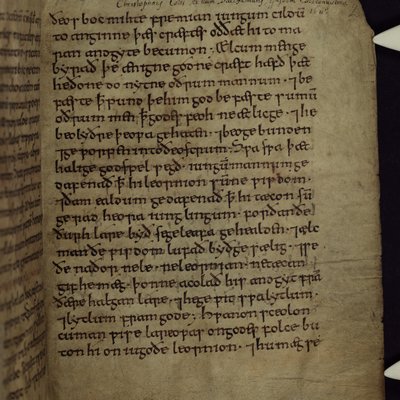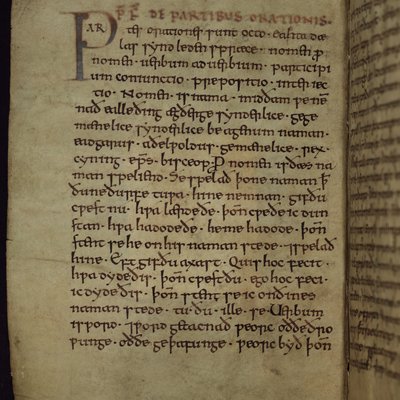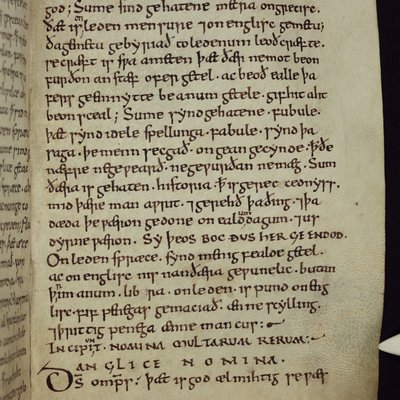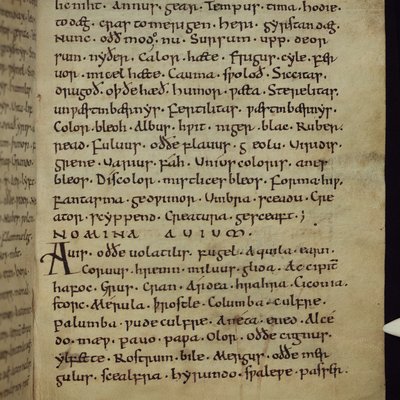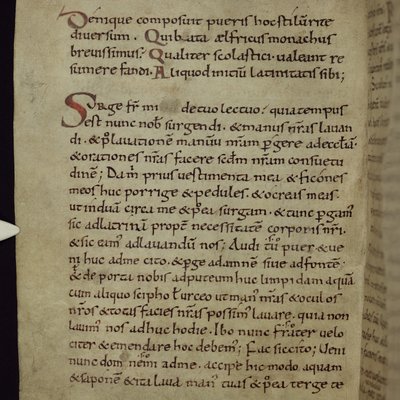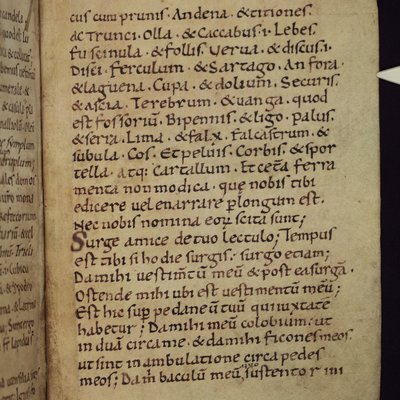March 2023
MS 154 is a “textbook” to learn Latin, complete with grammar, glossary, and conversational exercises (called colloquies). It is over 1,000 years old!
Despite its humble appearance, this little volume is an extraordinary survivor from early medieval England. It contains the earliest and most complete copy of Ælfric’s Grammar and Glossary (fols 1r-160r). The Latin grammar is the first ever written in any vernacular language. The author of both works is Ælfric of Eynesham (c. 950-c.1010). Largely forgotten today, Ælfric was one of the most learned Anglo-Saxon scholars and the most prolific Old English author known to us. Although an excellent Latinist, Ælfric mainly wrote in English to fulfil his life-long ambition of improving the Christian learning among monks, secular clerics, and even laity.
After prefaces in Latin and English , the Grammar begins with brief discussions of the sounds of speech, letters, syllables, and diphthongs. Ælfric then devotes the remainder of the work to the eight parts of speech: nouns, pronouns, verbs, adverbs, participles, conjunctions, prepositions, and interjections. He introduces each of these with its respective Latin term and English equivalent followed by further explanations and copious examples (which include comprehensive lists of noun declensions and verb conjugations). In short, Ælfric’s Grammar pretty much does what a modern grammar of Latin does, albeit less clearly structured than today’s learners would expect it and without the convenient table format for the all-important declensions and conjugations.
The bilingual glossary is a so-called ‘class glossary’, which lists words by subjects rather than alphabetically. In most cases Ælfric presents simple one-to-one translations of religious terms, animal names, names of herbs and trees, occupations, illnesses, crimes, and much more. The Grammar and Glossary were commonly copied together and complemented each other as classroom texts (Hill, ‘Ælfric’s Grammatical Triad’, p. 289). The high survival rate of Anglo-Saxon copies of the Grammar (nine fairly complete copies plus four fragments) and the Glossary (following the Grammar in six copies) demonstrates that the Grammar was ‘much copied’ and ‘clearly met a need’ (ibid, p. 291).
By contrast, the four colloquies which make up the remainder of St John’s MS 154 have a very low survival rate. In fact, the first, second and fourth have survived only in our manuscript. A colloquy (colloquium ‘speaking together, conversation’) is a verbal language exercise consisting of a string of dialogues designed for classroom practice. Like the study of grammar and vocabulary, colloquies were standard components of medieval language teaching. The first and second colloquies were composed by Ælfric Bata, a student of Ælfric of Eynsham. The third and fourth colloquies are redactions Bata made of already extant works. Indeed, the third is a redaction of a colloquy originally composed by his teacher, Ælfric of Eynsham. Only in St John’s manuscript do Bata’s colloquies follow Ælfric of Eynsham’s Grammar and Glossary.
Towards the end of the 11th century, another text was added on the last folio of St John’s MS 154. Now difficult to read, this is an extract from the prose version of Book 3 of Abbo of St Germain’s De bellis Parisiacae urbis together with a continuous Old English gloss. Originally a poem, the first two books provide an eye-witness report of the Viking siege of Paris (885-886), while the third book places the events into a theological context by aiming to educate young clerics in morality. The vocabulary used by Abbo is a treasure trove for those practicing the difficult Anglo-Latin 'hermeneutic style' adopted by Ælfric Bata and many other Anglo-Latin writers, but avoided by Ælfric of Eynshem in his Latin writings. Whoever added this extract must have thought it would complement Bata’s colloquies nicely as well as Ælfric of Eynsham’s aim of improving Christian learning in England after the destruction wrought by Viking attacks.
David Porter has argued that all of the early 11th-century texts in St John’s MS 154 ‘were first combined by Ælfric Bata and have been transmitted together wholesale’ (Porter, ‘Anglo-Saxon Colloquies’, p. 475). While others have proposed that St John’s manuscript may have been a copy of an exemplar that originated with Bata, Porter has suggested that it was ‘likely that the Oxford manuscript itself came from Bata’s scriptorium’ (ibid). Unfortunately, there is no evidence to support this enticing suggestion. Wherever it had been produced, our manuscript was in the library of Durham Cathedral by the late 12th century, where it is known to have remained at least until 1416. The next known event in MS 154’s history sees it donated to St John’s College by one Christopher Cole, a Fellow of St John’s, in the early 17th century, possibly 1611. The latest stage in the history of MS 154 was its rebinding in the 2010s, an account of which is available here.
A more detailed introduction of MS 154 is available in the blog post 'Libarian’s Pick #3: A Latin Textbook from Early Medieval England (MS 154)'.
References
Hill, Joyce, ‘Ælfric’s Grammatical Triad’, Form and Content of Instruction in Anglo-Saxon England in the Light of Contemporary Manuscript Evidence: Papers Presented at the International Conference Udine, 6-8 April 2006, ed. Patrizia Lendinara, Loredana Lazzari and Maria Amalia d’Aronco, Textes et études du Moyen Age, 39 (Turnhout: Brepols, 2007), pp. 285-307
Porter, David W., ‘Anglo-Saxon Colloquies: Ælfric, Ælfric Bata and De raris fabulis retractata’, Neophilologus 81 (1997), 467-80

